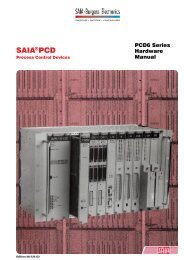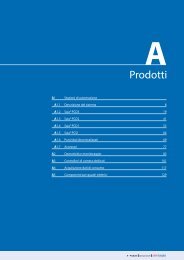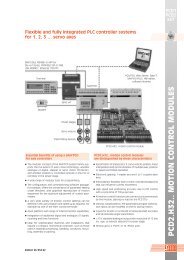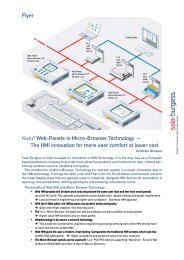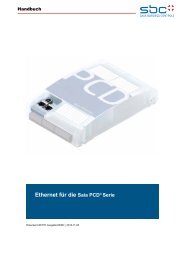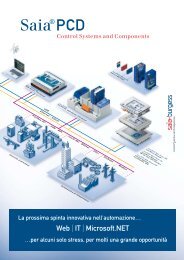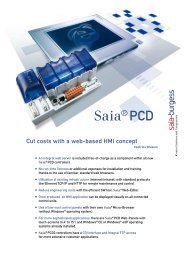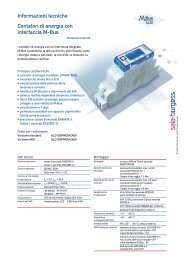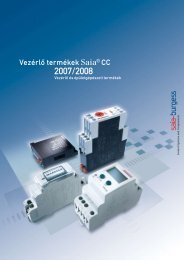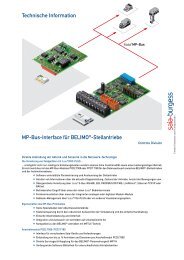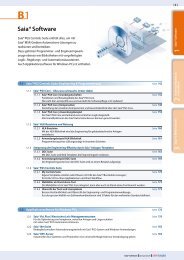PROFIBUS-DP & Profi-S-IO - SBC-support
PROFIBUS-DP & Profi-S-IO - SBC-support
PROFIBUS-DP & Profi-S-IO - SBC-support
Create successful ePaper yourself
Turn your PDF publications into a flip-book with our unique Google optimized e-Paper software.
Saia-Burgess Controls Ltd<br />
Bahnhofstrasse 18 I CH-3280 Murten I Switzerland<br />
T +41 (0)26 672 71 11 I F +41 (0)26 670 44 43<br />
Provisional documentation, <strong>Profi</strong>bus-<strong>DP</strong> and <strong>Profi</strong>-S-<strong>IO</strong><br />
Contents<br />
1 INTRODUCT<strong>IO</strong>N 3<br />
2 CONFIGURAT<strong>IO</strong>N 3<br />
2.1 INTERFACES 3<br />
2.2 POSSIBLE COMBINAT<strong>IO</strong>NS 3<br />
2.2.1 Overview 3<br />
2.2.2 Configuration details 4<br />
2.2.3 Recommended and tested Siemens CPUs 5<br />
2.3 <strong>DP</strong> MASTER AT F750 6<br />
2.4 ONBOARD MPI INTERFACE 6<br />
2.4.1 Overview 6<br />
2.4.2 Baud rates <strong>support</strong>ed 6<br />
2.4.3 <strong>DP</strong> slave 7<br />
2.4.4 <strong>Profi</strong>-S-<strong>IO</strong> master 7<br />
3 BEHAV<strong>IO</strong>UR 7<br />
3.1 GENERAL 7<br />
3.1.1 STOP-RUN 7<br />
3.1.2 Power-on 7<br />
3.2 MPI INTERFACE 7<br />
3.2.1 Reconfigure 7<br />
3.2.2 Clear/Reset 8<br />
3.2.3 Power-on 8<br />
3.2.4 FW download 8<br />
3.3 PLUG-INS 8<br />
4 MPI COMMUNICAT<strong>IO</strong>N WITH DIFFERENT PARTNERS 9<br />
4.1 PROGRAMMING 9<br />
4.1.1 MPI interface 9<br />
4.1.2 Serial interface 9<br />
4.2 MPI AND <strong>DP</strong>/PROFI-S-<strong>IO</strong> AT SAME INTERFACE SIMULTANEOUSLY 9<br />
4.2.1 General 9<br />
4.2.2 MPI terminal 9<br />
4.2.3 MPI communication with controllers of the older PCD2.M1x7 series 9<br />
5 TROUBLESHOOTING 10<br />
1/11
Saia-Burgess Controls Ltd<br />
Bahnhofstrasse 18 I CH-3280 Murten I Switzerland<br />
T +41 (0)26 672 71 11 I F +41 (0)26 670 44 43<br />
5.1 CHECK LIST 10<br />
5.2 SPECIAL CASES 10<br />
5.2.1 Master configuration with just one slave 10<br />
5.2.2 Master configuration with several slaves 10<br />
6 SFCS FOR <strong>DP</strong> FUNCT<strong>IO</strong>NALITIES 10<br />
6.1 SFC11: SYNCHRONIZE GROUPS OF <strong>DP</strong> SLAVES 10<br />
6.2 SFC12: DEACTIVATE AND ACTIVATE <strong>DP</strong> SLAVES 10<br />
6.3 SFC13: READ DIAGNOSTIC DATA OF A <strong>DP</strong> SLAVE (SLAVE DIAGNOSIS) 11<br />
2/11
Saia-Burgess Controls Ltd<br />
Bahnhofstrasse 18 I CH-3280 Murten I Switzerland<br />
T +41 (0)26 672 71 11 I F +41 (0)26 670 44 43<br />
1 Introduction<br />
The new Saia xx7 controllers, which are based on the Saia-NT operating system<br />
(PCD2.M487, PCD3.Mxxx7 …) offer various ways of connecting to <strong>PROFIBUS</strong>-<strong>DP</strong> and<br />
MPI, some of which have to be specially configured, or behave differently from Siemens<br />
controllers.<br />
This document describes all the possibilities and serves as a basis for the user guide.<br />
2 Configuration<br />
2.1 Interfaces<br />
A PCD2.M487 has 4 interfaces offering communication via <strong>PROFIBUS</strong>-<strong>DP</strong> and/or MPI.<br />
Interface <strong>DP</strong> master <strong>Profi</strong>-S <strong>IO</strong> master <strong>DP</strong> slave MPI<br />
PGU RS-232 - - - X<br />
Onboard MPI RS-485 - X X X<br />
F750, Slot B1 X - - X<br />
F750, Slot B2 X - - X<br />
Due to it many possibilities, the MPI interface deserves particular attention and is therefore<br />
described in more detail in § 2.4.<br />
Slots B1 and B2 are not present on the PCD3.Mxxx7.<br />
2.2 Possible combinations<br />
2.2.1 Overview<br />
When using different interfaces and protocols at the same time, the following combinations<br />
are possible:<br />
Protocol <strong>DP</strong> slave <strong>Profi</strong>-S-<strong>IO</strong> master <strong>DP</strong> master <strong>DP</strong> master<br />
Interface Onboard MPI Onboard MPI F750, Slot B1 F750, Slot B2<br />
- X X -<br />
- X - X<br />
X - X<br />
X - - X<br />
- - X X<br />
Regardless of these combinations, programming basically remains possible at every<br />
interface. However, in the case of an F750 module, it must be configured for that purpose.<br />
Simultaneous communication as <strong>DP</strong> slave and <strong>Profi</strong>-S-<strong>IO</strong> master is not possible via the<br />
onboard MPI interface.<br />
3/11
Saia-Burgess Controls Ltd<br />
Bahnhofstrasse 18 I CH-3280 Murten I Switzerland<br />
T +41 (0)26 672 71 11 I F +41 (0)26 670 44 43<br />
2.2.2 Configuration details<br />
All <strong>DP</strong> configurations are created using the hardware configurator in the SIMATIC<br />
Manager. The configuration is then interpreted and applied according to the following<br />
criteria:<br />
• Loaded configuration in SDBs<br />
• F750 modules plugged into slots B1 and/or B2<br />
• Value of <strong>Profi</strong>-S-<strong>IO</strong> flag in CDB<br />
• Ident number or firmware version of configured CPU<br />
The <strong>Profi</strong>-S-<strong>IO</strong> master is configured in exactly the same way as a <strong>DP</strong> master, although it<br />
requires an additional entry in the CDB. All master interfaces can be integrated within the<br />
CPU, or configured as CPs.<br />
The following table shows a complete overview of firmware versions for Siemens CPUs,<br />
when they are to be configured for the various possible combinations.<br />
No Number <strong>Profi</strong>-S- <strong>DP</strong> slave <strong>Profi</strong>-S-<strong>IO</strong> <strong>DP</strong> master <strong>DP</strong> master<br />
of F750 <strong>IO</strong> flag<br />
master<br />
modules<br />
Onboard MPI Onboard MPI F750, Slot B1 F750, Slot B2<br />
Integral Integr. CP Integr. CP Integr. CP<br />
Siemens<br />
family<br />
1 0 Disable V1.x - - - - - - 300/400<br />
2 Enable - V1.x - - - - - 300/400<br />
3<br />
Enable - - V1.x - - - - 400<br />
4 1 Disable - - - V1.x - - - 300/400<br />
5 Disable - - - - V1.x - - 400<br />
6 Disable - - - - - V1.x - 300/400<br />
7 Disable - - - - - - V1.x 400<br />
8 Enable - V1.x - - V1.x - - 400<br />
9 Enable - V1.x - - - - V1.x 400<br />
10<br />
don’t<br />
V3.0 - - - V3.0 - - 400<br />
care<br />
11<br />
don’t<br />
V3.0 - - - - - V3.0 400<br />
care<br />
12 2 Disable 1 - - - V1.x - - V1.x 400<br />
Important: the following rules apply<br />
• The CPU firmware version is always crucial. The CP version is irrelevant.<br />
• Only the combinations listed above may be configured. All other combinations are<br />
not <strong>support</strong>ed and may result in undesirable behaviour.<br />
• Whenever a CP is configured, the corresponding CPU must be configured with<br />
firmware V1.x. Combinations 10 and 11 are the only specific exceptions to this rule.<br />
• Only CPs from the 400 series are <strong>support</strong>ed.<br />
1 If the <strong>Profi</strong>-S-<strong>IO</strong> flag is set to ‘Enable’ while two F750 modules are plugged in, combination 4 will<br />
apply.<br />
4/11
Saia-Burgess Controls Ltd<br />
Bahnhofstrasse 18 I CH-3280 Murten I Switzerland<br />
T +41 (0)26 672 71 11 I F +41 (0)26 670 44 43<br />
• Combinations 8 to 12, which have two <strong>DP</strong> interfaces configured simultaneously, can<br />
only be achieved with CPUs from the 400 series.<br />
• Configuration of a master at the integral interface of a CPU with firmware V3.0 is not<br />
<strong>support</strong>ed.<br />
• CPUs with firmware V2.0 are not <strong>support</strong>ed by any combination.<br />
2.2.3 Recommended and tested Siemens CPUs<br />
All Siemens CPUs are listed here that have been tested for the different combinations. Other<br />
CPUs may also be possible, as long as they meet the above criteria.<br />
Combination 1: <strong>DP</strong> slave on onboard MPI<br />
CPU 315-2 <strong>DP</strong> 315-2AF03-0AB0<br />
CPU 316-2 <strong>DP</strong> 316-2AG00-0AB0<br />
CPU 318-2 <strong>DP</strong> 318-2AJ00-0AB0<br />
V1.0, V1.1, V1.2<br />
Combinations 2, 3, 4, 5, 6 and 7: <strong>Profi</strong>-S-<strong>IO</strong> or <strong>DP</strong> master as integral or CP interface<br />
Integral interface:<br />
CPU 414-2 <strong>DP</strong> 414-2XG03-0AB0 V1.1, V1.2<br />
CPU 315-2 <strong>DP</strong> 315-2AF03-0AB0<br />
CPU 316-2 <strong>DP</strong> 316-2AG00-0AB0 V1.0, V1.1, V1.2<br />
CPU 318-2 <strong>DP</strong> 318-2AJ00-0AB0<br />
CP:<br />
CP 443-5 443-5DX02-0XE0 V 2.0<br />
Combinations 8, 9 and 12: two simultaneous masters<br />
Integral interface:<br />
CPU 414-2 <strong>DP</strong> 414-2XG03-0AB0 V1.1, V1.2<br />
CP:<br />
CP 443-5 443-5DX02-0XE0 V 2.0<br />
5/11
Saia-Burgess Controls Ltd<br />
Bahnhofstrasse 18 I CH-3280 Murten I Switzerland<br />
T +41 (0)26 672 71 11 I F +41 (0)26 670 44 43<br />
Combinations 10 and 11: simultaneous <strong>DP</strong> slave and <strong>DP</strong> master<br />
In this combination, "<strong>DP</strong> Mode" must always be set to "S7 compatible"!<br />
Slave (integral interface):<br />
In this combination, selection of a CPU with firmware V3.0 is mandatory. The only CPUs<br />
<strong>support</strong>ed are those listed here.<br />
CPU 412-2 <strong>DP</strong><br />
CPU 414-2 <strong>DP</strong><br />
CPU 416-3 <strong>DP</strong><br />
412-2XG00-0AB0<br />
414-2XG03-0AB0<br />
416-3XL00-0AB0<br />
V3.0<br />
Master (CP):<br />
CP 443-5 443-5DX02-0XE0 V 3.0<br />
2.3 <strong>DP</strong> master at F750<br />
The <strong>DP</strong> master can be configured as standard.<br />
2.4 Onboard MPI interface<br />
2.4.1 Overview<br />
The onboard MPI interface offers the following communications possibilities:<br />
No. <strong>Profi</strong>-S-<strong>IO</strong> master <strong>DP</strong> slave MPI<br />
1 - - X<br />
2 - X X<br />
3 X - X<br />
This interface is special because a single physical interface <strong>support</strong>s several protocols. They<br />
have to be configured in different places within the Siemens hardware configurator, because<br />
the corresponding Siemens CPUs provide a separate physical interface for each protocol.<br />
For this reason, the following points should be noted when configuring a <strong>DP</strong> slave or <strong>Profi</strong>-<br />
S-<strong>IO</strong> master:<br />
• The master/slave address must be the same as the MPI address. All other bus<br />
parameters (baud rate, HSA, timing) are taken from the <strong>DP</strong> configuration, regardless<br />
of the MPI parameters configured.<br />
• The entire bus parameters for a valid <strong>DP</strong> configuration are stored in EEPROM, just<br />
like the MPI parameters. Parameters saved will remain here, even after a primary<br />
delete and power-on. They will only be overwritten when a new MPI configuration<br />
(without <strong>DP</strong> configuration) is loaded.<br />
2.4.2 Baud rates <strong>support</strong>ed<br />
The onboard interface <strong>support</strong>s the following baud rates:<br />
6/11
Saia-Burgess Controls Ltd<br />
Bahnhofstrasse 18 I CH-3280 Murten I Switzerland<br />
T +41 (0)26 672 71 11 I F +41 (0)26 670 44 43<br />
93.75 kBaud, 187.5 kBaud, 500 kBaud, 1.5 MBaud<br />
If an un<strong>support</strong>ed baud rate is configured, two alternative scenarios are possible:<br />
1. If the configuration applies to the MPI only, the default baudrate of 187.5 kBaud will<br />
be set automatically.<br />
2. If a <strong>DP</strong> configuration contains an invalid baud rate, the last valid bus configuration<br />
will remain active.<br />
2.4.3 <strong>DP</strong> slave<br />
The actual slave configuration should be implemented in the standard way. Make sure that<br />
MS mode (master-slave) is selected for each I/O declaration line.<br />
2.4.4 <strong>Profi</strong>-S-<strong>IO</strong> master<br />
<strong>Profi</strong>-S-<strong>IO</strong> master is configured exactly like <strong>DP</strong> master.<br />
An additional entry in the CDB is needed to specify that the master configuration is not<br />
intended for an F750 interface, but for the onboard <strong>Profi</strong>-S-<strong>IO</strong> master. This entry is defined<br />
as follows:<br />
‚<strong>Profi</strong>-S-<strong>IO</strong>:Enable’<br />
This entry must be in the CDB before the <strong>Profi</strong>-S-<strong>IO</strong> master can be activated.<br />
3 Behaviour<br />
3.1 General<br />
3.1.1 STOP-RUN<br />
Every <strong>DP</strong> configuration that is loaded will only be activated by a STOP-RUN transition.<br />
Equally, when a <strong>DP</strong> configuration is deleted (or new MPI configuration loaded), this change<br />
will only be implemented at the next STOP-RUN transition.<br />
If a STOP-RUN transition is executed in the absence of any change to the configuration, the<br />
relevant interfaces will continue to run without interruption.<br />
3.1.2 Power-on<br />
Interfaces are not initialized by a power-on. This only happens with a STOP-RUN transition.<br />
3.2 MPI interface<br />
3.2.1 Reconfigure<br />
When the parameters of the MPI interface are changed, they will normally become active<br />
directly after loading. However, this does not apply in the following situations:<br />
• When another MPI connection remains active (e.g. monitor variables)<br />
7/11
Saia-Burgess Controls Ltd<br />
Bahnhofstrasse 18 I CH-3280 Murten I Switzerland<br />
T +41 (0)26 672 71 11 I F +41 (0)26 670 44 43<br />
• When there is an active <strong>DP</strong> configuration and then a new MPI configuration is<br />
loaded, without a <strong>DP</strong> configuration. In this case, the MPI parameters will only<br />
become active at the STOP-RUN transition.<br />
In some circumstances, the following situation can lead to undesirable behaviour on the bus:<br />
• When an MPI configuration is active (i.e. not master/slave) and a new configuration<br />
is loaded with modified (!) MPI parameters and an additional <strong>DP</strong> configuration, the<br />
interface will be reinitialized twice: directly after loading the modified MPI<br />
parameters and at the next STOP-RUN transition for the <strong>DP</strong> parameters.<br />
3.2.2 Clear/Reset<br />
The Clear/Rest functionality will delete the master or slave configuration. However, the<br />
corresponding bus parameters (address, baud rate, profile) will not be deleted and will<br />
remain active.<br />
3.2.3 Power-on<br />
After a power-on, the MPI interface will be initialized with the last valid bus parameters<br />
(address, baud rate, profile), regardless of whether they come from an MPI or <strong>DP</strong><br />
configuration.<br />
3.2.4 FW download<br />
After a firmware download, the last valid bus parameters (address, baud rate, profile) will<br />
remain active.<br />
3.3 Plug-Ins<br />
When the DB containing a plug-in has been downloaded to the master controller, it is<br />
necessary to execute a power-on, so that the file is recognized.<br />
8/11
Saia-Burgess Controls Ltd<br />
Bahnhofstrasse 18 I CH-3280 Murten I Switzerland<br />
T +41 (0)26 672 71 11 I F +41 (0)26 670 44 43<br />
4 MPI communication with different partners<br />
4.1 Programming<br />
4.1.1 MPI interface<br />
If a <strong>DP</strong> slave or <strong>Profi</strong>-S-<strong>IO</strong> master is configured on the MPI interface, it will still be possible<br />
to program via this interface.<br />
This will require setting the PG/PC interface to PC Adapter (<strong>PROFIBUS</strong>) in the SIMATIC<br />
Manager, and setting Properties with the same configuration as selected for the slave/master<br />
in the bus parameters.<br />
4.1.2 Serial interface<br />
For programming via the serial RS-232 interface, the PG/PC interface must always be set to<br />
PC Adapter (MPI) in the SIMATIC Manager.<br />
4.2 MPI and <strong>DP</strong>/<strong>Profi</strong>-S-<strong>IO</strong> at same interface simultaneously<br />
4.2.1 General<br />
The onboard MPI interface allows communication across MPI while a <strong>DP</strong> slave or <strong>Profi</strong>-S-<br />
<strong>IO</strong> master is active at the same time. Since the <strong>DP</strong> parameters are always used for bus<br />
configuration when a slave or master is active, it is particularly important to ensure that the<br />
MPI communications partner is using the correct bus parameters. These must be the same<br />
parameters as in the <strong>DP</strong> configuration, and not those of the standard MPI interface, which<br />
would normally be used.<br />
4.2.2 MPI terminal<br />
Since bus parameters cannot, as a rule, be set for an MPI terminal, this situation calls for<br />
selection of a <strong>DP</strong> configuration with bus parameters that match those of the MPI terminal.<br />
To run an ESA MPI terminal simultaneously with <strong>DP</strong>, the following bus parameters must be<br />
selected in the <strong>DP</strong> configuration:<br />
Baud rate: 187.5 kBaud<br />
<strong>Profi</strong>le:<br />
Universal; or <strong>DP</strong> profile and slot time = set 150 bits<br />
This has been tested with an ESA VT50.<br />
4.2.3 MPI communication with controllers of the older PCD2.M1x7 series<br />
To communicate across the MPI with a PCD2.M1x7 series controller when there is a<br />
simultaneous <strong>DP</strong>/<strong>Profi</strong>-S-<strong>IO</strong> configuration, the following parameters must be selected in the<br />
<strong>DP</strong>/<strong>Profi</strong>-S<strong>IO</strong> configuration:<br />
Baude rate: 187.5 kBaud<br />
<strong>Profi</strong>le:<br />
Universal<br />
9/11
Saia-Burgess Controls Ltd<br />
Bahnhofstrasse 18 I CH-3280 Murten I Switzerland<br />
T +41 (0)26 672 71 11 I F +41 (0)26 670 44 43<br />
5 Troubleshooting<br />
5.1 Check list<br />
If errors occur, check the following points first:<br />
• Is the <strong>Profi</strong>-S-<strong>IO</strong> flag set (or not set) correctly?<br />
• Is the address of the <strong>DP</strong> slave or <strong>Profi</strong>-S-<strong>IO</strong> master the same as the MPI address?<br />
• Does the firmware version of the selected CPU satisfy the rules set out in § 2.2.2<br />
• Have all F750 modules inserted also been configured?<br />
• Have all the rules set out in § 2.2.2 been followed?<br />
• Is the configured baud rate <strong>support</strong>ed by the onboard MPI interface, as described<br />
in § 2.4.1?<br />
5.2 Special cases<br />
If an invalid or inconsistent configuration is loaded that does not meet requirements, the<br />
controller will, as a rule, switch to the STOP state. The message: Stopped by peripherals<br />
management will be entered in the diagnostic buffer.<br />
In a few exceptional cases, however, a configuration may not even be recognized as such, or<br />
else it may be wrongly interpreted and activated.<br />
5.2.1 Master configuration with just one slave<br />
If the slave has the same address as the controller's MPI address, the configuration will be<br />
interpreted as a slave configuration and the controller started without error message.<br />
Eliminate error by setting the <strong>Profi</strong>-S-<strong>IO</strong> flag, or plugging a F750 module.<br />
5.2.2 Master configuration with several slaves<br />
The configuration is not recognized and the controller starts without an error message.<br />
Eliminate error by setting the <strong>Profi</strong>-S-<strong>IO</strong> flag, or plugging a F750 module.<br />
6 SFCs for <strong>DP</strong> functionalities<br />
Three SFCs offer functions associated with <strong>PROFIBUS</strong>-<strong>DP</strong> and have been implemented on<br />
Saia controllers with maximum compatibility. Implementation ist basically the same as for<br />
the F750 module and the <strong>Profi</strong>-S-<strong>IO</strong> master.<br />
6.1 SFC11: Synchronize groups of <strong>DP</strong> slaves<br />
SFC11 can be used to transfer Sync and Freeze commands to slaves.<br />
The <strong>Profi</strong>-S-<strong>IO</strong> master does not currently <strong>support</strong> this functionality.<br />
6.2 SFC12: Deactivate and activate <strong>DP</strong> slaves<br />
SFC12 can be used to deactivate and then reactivate configured slaves.<br />
10/11
Saia-Burgess Controls Ltd<br />
Bahnhofstrasse 18 I CH-3280 Murten I Switzerland<br />
T +41 (0)26 672 71 11 I F +41 (0)26 670 44 43<br />
The following functionalities are <strong>support</strong>ed with Siemens compatibility:<br />
• Basically all parameters: REQ, MODE, LADDR, RET_VAL and BUSY<br />
• When a <strong>DP</strong> slave is deactivated with SFC 12, its process outputs will be set to the<br />
projected default values or to 0 (secure state).<br />
• When a <strong>DP</strong> slave is deactivated with SFC 12, the <strong>DP</strong> master will not subsequently<br />
respond to that <strong>DP</strong> slave.<br />
• When a <strong>DP</strong> slave is reactivated with SFC 12, it will be configured and its parameters<br />
set by the appropriate <strong>DP</strong> master (as for the return of a <strong>DP</strong> station after failure).<br />
• Deactivated slaves will be automatically reactivated after a power-on.<br />
• A STOP-RUN transition will leave the activation status of slaves unchanged:<br />
activated slaves remain activated, deactivated slaves remain deactivated.<br />
The following functionalities are NOT <strong>support</strong>ed:<br />
• If your program directly accesses the effective data of a previously deactivated <strong>DP</strong><br />
slave, the peripheral access error OB (OB 122) will be called and the appropriate start<br />
event will be entered in the diagnostic buffer. If you access a deactivated <strong>DP</strong> slave<br />
via an SFC (e.g. SFC 59 RD_REC), you will receive the same error information in<br />
RET_VAL as for an unavailable <strong>DP</strong> slave.<br />
‣ OB 122 is not called and no event is entered in the diagnostic buffer.<br />
• If you try to use SFC 12 to reactivate a deactivated slave that is physically separate<br />
from the <strong>DP</strong> bus, the LED "<strong>DP</strong>-BUSF" on the CPU will flash for about one minute.<br />
After this monitoring time has elapsed, the SFC will return error code W#16#80A2,<br />
the LED will go off, and the slave will remain deactivated. If at a later time its<br />
connection to the <strong>DP</strong> bus is restored, you must reactivate the slave with SFC 12.<br />
‣ The slave is immediately activated, even if it is not connected to the bus, and<br />
the SFC does not return an error code. As soon as the slave is reconnected to<br />
the bus, the connection is established and data exchanged.<br />
• If you want to cancel a current activation job, start SFC 12 with the same value for<br />
LADDR and MODE = 2. Keep calling SFC 12 with MODE = 2 until the successful<br />
cancellation of the activation job is displayed with RET_VAL = 0.<br />
‣ An activation job cannot be cancelled.<br />
6.3 SFC13: Read diagnostic data of a <strong>DP</strong> slave (slave diagnosis)<br />
SFC13 can be used to read the diagnostic data of a <strong>DP</strong> slave.<br />
11/11



